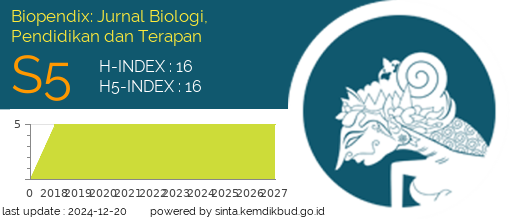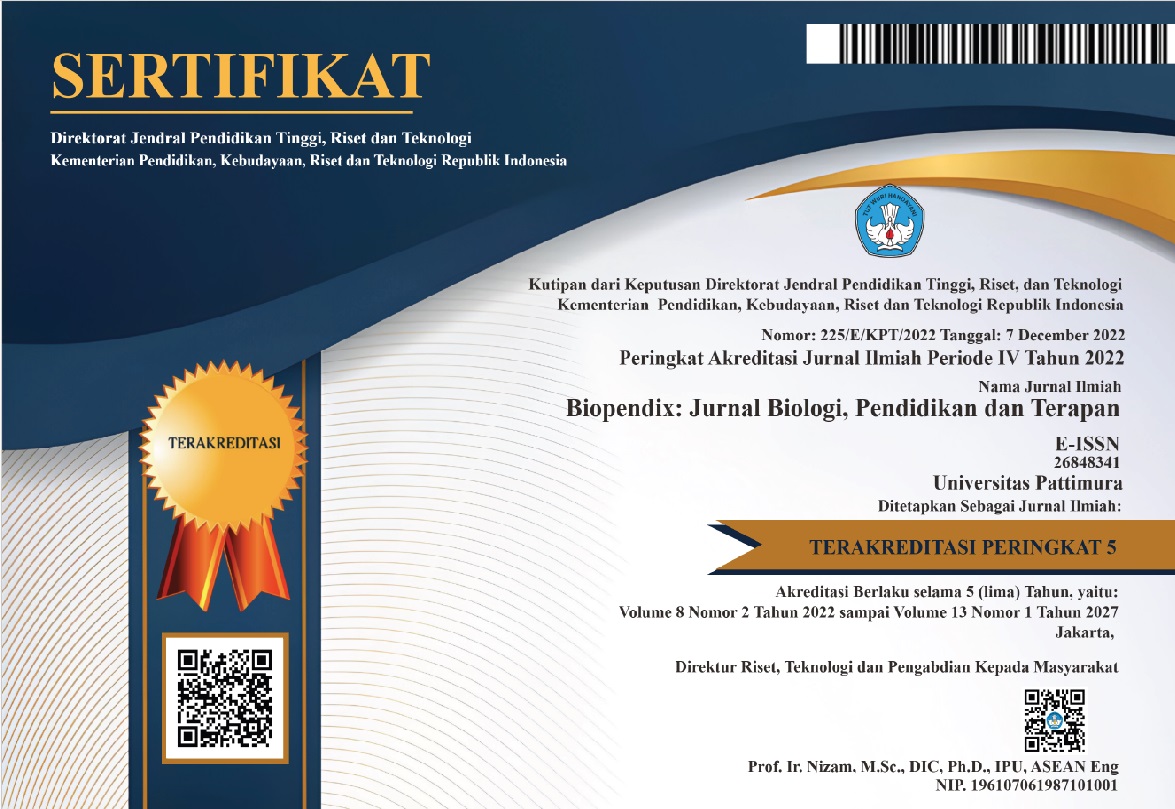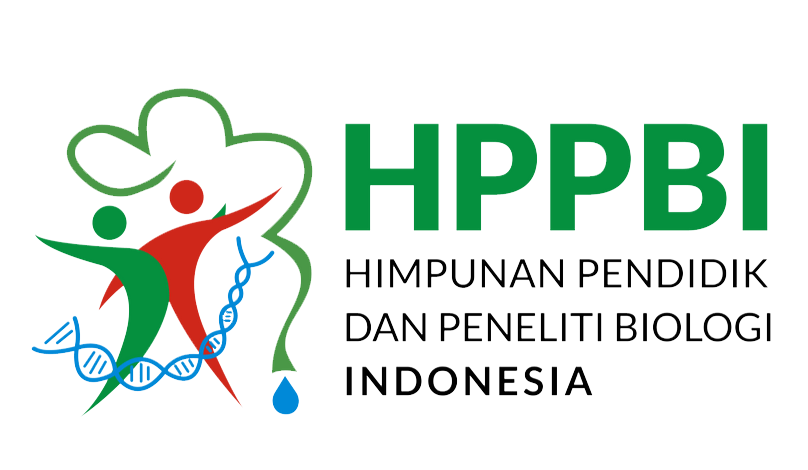KADAR LEMAK ES KRIM TEPUNG DAUN KELOR (Moringa oleifera) BERDASARKAN VARIASI VOLUME SARI KACANG TANAH (Arhacis hypogea)
Abstract
Background: Moringa leaves are rich in nutrients and are a source of antioxidants, but are underutilized by the public as a food ingredient because they smell ‘unpleasant '. In an effort to increase the benefits to extend the shelf life of the product and also attract the interest of the community to consume Moringa leaves, Moringa leaves can be processed into flour, then made ice cream with the addition of peanut juice.
Method: Implementation of this research was conducted at the Pattimura University Basic Biology Laboratory. This study uses a Completely Randomized Design (CRD). Data from the research results were analyzed using inferential statistics One Way Anova (ANOVA).
Results: There was an effect of adding variations of peanut juice (Arachis hypogea) to fat content in Moringa oleifera leaf ice cream ie control of 4,457%, addition of 50 ml peanut juice as much as 5,207%, addition of 75 ml peanut juice as much as 5,956% and the addition of 100 ml peanut juice, fat content of 5.993%.
Conclusion: There is an effect of adding variations in peanut juice (Arachis hypogea) to fat content in Moringa oleifera leaf ice cream.
Downloads
References
Darma, S.G., Puspitasari.D., Noerhatati.E. 2013. Pembuatan es krim jagung manis kajian zat penstabil, konsentrasi non dairy cream serta aspek kelayakan financial. Reka Agroindustri Volume 1 No 1.
Harris, A. 2011.Pengaruh subtitusi ubu jalar (Ipomea batatas) dengan susu skim terhadap pembuatan es krim. Skripsi tidak diterbitkan. Makassar: Fakultas PPertanian Universitas Hasanuddin.
Hardinsyah, Riyadi, H., Napitupulu, V. 2010. Kecukupan energy protein, lemak dan karbohidrat. Artikel Gizi. Departemen Gizi Masyarakat FEMA IPB.
Krisnadi, A.D. 2015. Kelor Super Nutrisi. Blora: Gerakan Swadaya Masyarakat Penanaman dan Pemanfaatan Tanaman Kelor Dalam rangka mendukung Gerakan Nasional Sadar Gizi Dan Mengatasi Malnutrisi di Indonesia: Moringa Indonesia.
Kurnianingsih, S.R. 2015.Pengaruh Penambahan Tepung Daun Kelor (Moringa oleifera) pada Karakteristik Fisikokimia dan Sensoris Es Krim.Skripsi tidak diterbitkan. Semarang: Fakultas Teknologi Pertanian Universitas Katolik Soegijapranata.
Putri, M.K.E., Lutfiati, D. 2014. Penambahan puree sukun (Artocarpus altilis F) pada pembuatan es krim ditinjau dari sifat fisik dan kandungan gizi. E-journal boga Volume 3 nomor 1 halaman 308-315.
Uswatun, H. A. 2011. Kandungan Gizi Dan Serat Pada Pembuatan Es Krim Kacang Merah. Skripsi tidak diterbitkan. Yogyakarta: Fakultas Teknik Universitas Negeri Yogyakarta.
Zakaria., Tamrin, A., Sirajuddin., Hartono.R. 2012.Penambahan Tepung Daun kelor pada menu makanan sehari-hari dalam upaya penanggulangan gizi.media gizi pangan. Vol XIII, edisi 1
Authors who publish with this Journal agree to the following terms:
- Author retain copyright and grant the journal right of first publication with the work simultaneously licensed under a creative commons attribution license that allow others to share the work within an acknowledgement of the work’s authorship and initial publication of this journal.
- Authors are able to enter into separate, additional contractual arrangement for the non-exclusive distribution of the journal’s published version of the work (e.g. acknowledgement of its initial publication in this journal).
- Authors are permitted and encouraged to post their work online (e.g. in institutional repositories or on their websites) prior to and during the submission process, as it can lead to productive exchanges, as well as earlier and greater citation of published works





 2
2






